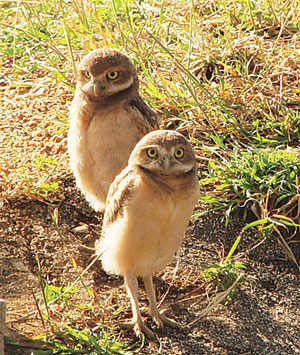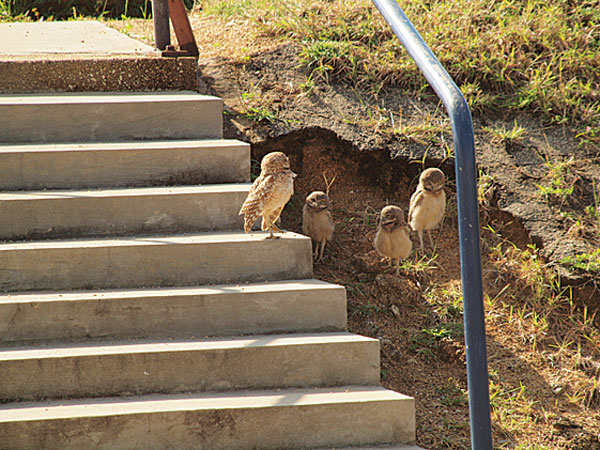courtesy of: The Morning News
by Rosalie Klein
 Why the Shoco?
Why the Shoco?
Well, as many would say: Why not? However, on Friday, February 17, after much lobbying by the Aruba Bird Conservation Foundation, Aruba’s indigenous owl, a variation of Athene cunicularia, the borrowing owl, was named Aruba’s national bird by Minister of Social & Economic Affairs and Culture, Michelle Hooyboer Winklaar.
Aruba has some very interesting native birds: the Chuchubi, Trupial and Prikichi, but why such great affection for the less colorful owl? THE MORNING NEWS was fortunate to be invited to meet a family of shocos that have set up housekeeping under the stairs of the Man Na Obra Center in Piedra Plat, a part of the Stichting Voor Verstandelijk Gehandicapten, or SVGA, the Foundation for the Mentally Challenged. Elvira Tromp, Director, says they greet her every day upon arrival, and perusing these pictures may help visitors understand why islanders have such affection for this shy, quite tiny owl. The center and the SVGA take great care in watching out for them and they actually have two nests with a total of 8 newborn shocos under their protection along with 3 sets of very protective parents.
There is a very practical side to making the shoco a national bird, as this should puts it under government protection; among the many birds threatened by encroachment on their habitats by Aruba’s building boom and the foothold gained by non-native predators like the boa constrictor, the shoco is perhaps one of the most vulnerable. Nesting in underground burrows makes it very easy for a voracious boa to devour their eggs or newborn owls, along with the protecting parents, depending on the size of the snake. Bulldozing certainly means death for these beautiful birds, and flying away to nest in another tree is not an option.
The greater significance of this landmark decision should mean that legislation will now be put in place to inspect potential construction sites and place strictures that will protect any nest found there, with steps taken by experts to move the birds before they are harmed. Regulations that fine builders and landowners who ignore this should follow; we can only hope.
We applaud those who worked so hard to see this proclamation come to pass, and the staff of the SVGA for taking such steps as to protect the avian residents of their premises.
